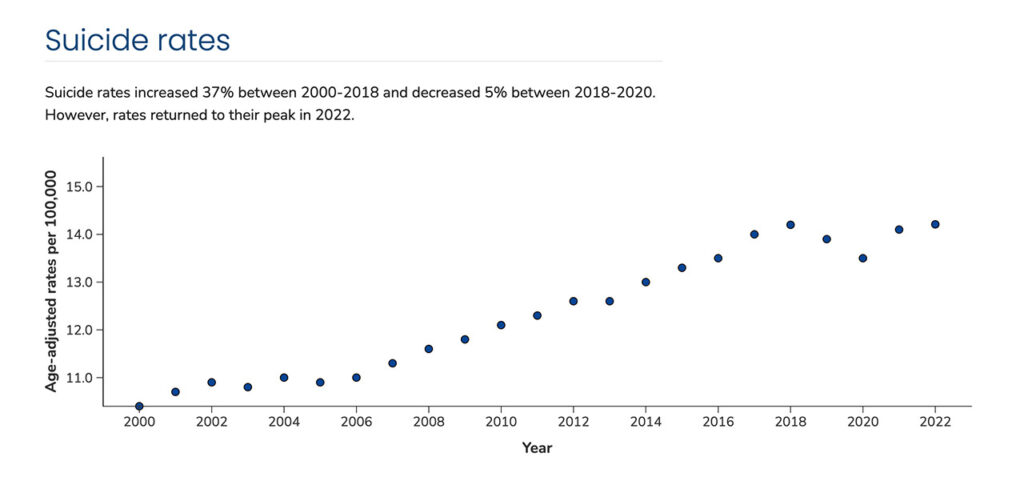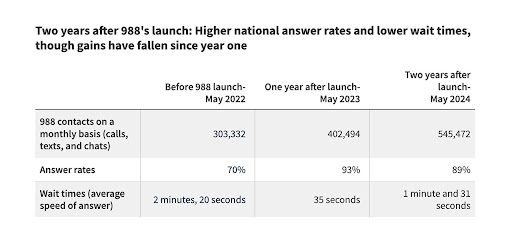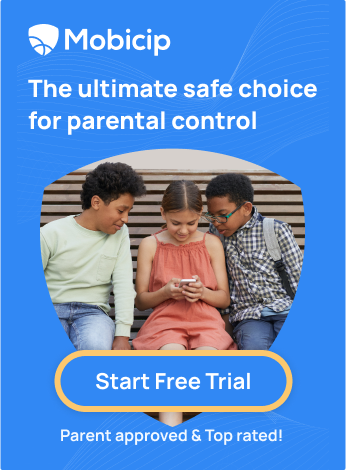What Parents Need to Know About 988 Lifeline

Sadly, too often, the stigma around mental health prevents people who need help from seeking it. But that simply doesn’t make any sense. Whether an illness affects your heart, your arm, or your brain, it’s still an illness, and there shouldn’t be any distinction. We would never tell someone with a broken leg that they should stop wallowing and get it together. We don’t consider taking medication for an ear infection something to be ashamed of. We shouldn’t treat mental health conditions any differently. Instead, we should make it clear that getting help isn’t a sign of weakness — it’s a sign of strength — and we should ensure that people can get the treatment they need.”
– Michelle Obama
As parents, it’s heartbreaking to witness the changes in our youth’s mental health. In a world filled with pressures, our children often feel overwhelmed, grappling with emotions that leave them feeling isolated and unheard. With all the shout out about mental health from celebrities and influencers, I really wonder how much are we aware of? How much are we making our kids aware? Let’s look at some stats about mental health and youth before we dive exploring 988 – a Lifeline for those in crisis.
Major Depressive Episodes (MDE)
- 20.17% of youth (ages 12-17) reported at least one MDE in the past year.
- Severe Impairment
- 15% of youth experienced MDE with severe impairment affecting their daily functioning.
Suicidal Thoughts
- 13.16% of youth (over 3.4 million) are experiencing serious thoughts of suicide.
Unmet Treatment Needs
- 56.1% of youth with major depression did not receive treatment.
- 48.3% reported an unmet need for treatment.
Flourishing Youth Statistics
- Only 60.5% of youth ages 6-17 meet criteria for flourishing, a positive indicator of mental health and well-being.
What is the 988 Lifeline?
988 is a toll-free number designed to provide immediate help in a crisis. In the U.S., it’s called the 988 Suicide & Crisis Lifeline. The idea is simple—when we or someone we care about is in emotional or mental distress, we can call or text 988 for support.
This service is for anyone struggling with thoughts of suicide, a mental health crisis, or substance use issues. And it’s not just for the person in crisis. We, as parents, can also call 988 if we’re worried about our child or anyone else we know.
The 988 Lifeline is part of a larger effort to reduce suicide in the U.S., supported by the Substance Abuse and Mental Health Services Administration (SAMHSA). It connects people to trained counselors who can listen, offer support, and point to local resources that can help.
Help is Just a Call, Text, or Chat Away 24/7 all year round.
Here’s a breakdown of the different types of support available:
- Veterans and Service Members – Extra support is available for families with veterans or service members. The Veterans Crisis Line is a part of the 988 Lifeline. This service also supports National Guard, Reserve members, and their loved ones.
- Support for Spanish Speakers – For those who speak Spanish, 988 offers voice, text, and chat options in Spanish.
- Deaf and Hard-of-Hearing Services – If someone is Deaf or hard of hearing, 988 provides videophone services.
- LGBTQI+ Youth and Young Adults – LGBTQI+ youth and young adults often face specific challenges. The 988 Lifeline offers specialized support for people under 25.
Why Was the 988 Lifeline Created?
Mental health is the new pandemic in our society. As parents, we’ve seen how mental health issues are becoming more common. Many of us worry about our kids, especially with the challenges they face today—school stress, social media, and just growing up in a fast-paced world.
The 988 Lifeline was created to address this growing need. It offers an easy-to-remember number for anyone in crisis. Here are some startling facts about mental illness:
- 1 in 5 U.S. adults experience mental illness each year.
- 1 in 20 U.S. adults experience serious mental illness each year.
- 1 in 6 U.S. youth aged 6-17 experience a mental health disorder each year.
- 50% of all lifetime mental illnesses begin by age 14, and 75% by age 24.
- Suicide is the 2nd leading cause of death among people aged 10-14.

Source: CDC
From 2004 to 2022, there was a significant increase in suicides, highlighting the urgent need for action from government bodies.
The journey to create the 988 Suicide & Crisis Lifeline began in 2004. The Substance Abuse and Mental Health Services Administration (SAMHSA) recognized the growing need for better crisis support as mental health challenges rose. To address this, SAMHSA launched the National Suicide Prevention Initiative. By January 2005, the National Suicide Prevention Lifeline was officially launched.
A significant boost to crisis response services came from federal investment in mental health initiatives. This funding allowed for the expansion of resources, training, and support for crisis centers nationwide. With over 200 local and state-funded crisis call centers available, the Lifeline could effectively help those in crisis, making it a vital resource for families.
In 2018, the U.S. government made the Lifeline even more accessible by creating a three-digit number. After a series of recommendations, the Federal Communications Commission (FCC) approved the number 988 for the hotline. This new number replaced the longer 1-800 version, making it easier for people to remember in a crisis.
The 988 Lifeline officially went live on July 16, 2022. Since then, more efforts have been made to improve the service, including text options for those who are deaf or hard of hearing.

How the 988 Lifeline Works
Accessing the Lifeline
You can reach the 988 Lifeline in three ways: by calling, texting, or chatting online.
Calling the 988 Lifeline
- When you call, you’ll hear a message with different service options.
- You might hear hold music while waiting to connect with a counselor. If you’re a veteran, your call will ring until someone is available.
Chatting with the 988 Lifeline
- Click “Chat With Us” to open a brief survey. It helps the counselors understand your needs.
- Clicking “Start a Chat” means you agree to their terms of service.
- You’ll see a message while they connect you to a counselor.
Texting the 988 Lifeline
- Text 988 and choose from options for veterans, Spanish-speaking, or the main Lifeline.
- Text “next” to accept the terms of service.
- Complete a quick survey to help the counselor understand your needs.
- You’ll get a “wait” message while they connect you to a counselor.
After following these steps, here’s what happens:
- A friendly counselor will answer and introduce themselves.
- They will ask if you feel safe.
- After checking your safety, the counselor will listen to you, understand your situation, and provide support and resources.
Confidentiality and Availability
One of the best things about the 988 Lifeline is that it’s confidential and free. You can reach out anytime without fear of judgment.
Languages Supported
The 988 Lifeline supports English and Spanish. If you call 988 and press 2, you’ll be connected to a Spanish-speaking counselor. For other languages, you can call 988, and you will receive translation services in over 240 languages through Language Line Solutions. This ensures that everyone can access help, regardless of their preferred language.
The Role of Parents in Utilizing the 988 Lifeline
As parents, our role is vital in supporting our children’s mental health. We need to be aware of how we can support our children, especially when it comes to using the 988 Lifeline. Here’s how we can help.
Recognizing Signs of Crisis
Knowing the signs of a mental health crisis is the first step. Here are some things to look out for:
- Changes in Mood: If your child seems sad, anxious, or irritable for a long time, it could be a sign of trouble.
- Withdrawal: Notice if they start isolating themselves from friends and family. This can be a red flag.
- Changes in Sleep or Eating: If they’re sleeping too much or not enough, or if their eating habits change drastically, pay attention.
- Loss of Interest: If your child stops enjoying activities they once loved, it’s time to talk.
- Talking About Self-Harm: If they mention feeling hopeless or talk about wanting to harm themselves, take it seriously.
Encouraging Open Communication
When we talk openly, we help our kids feel less alone. Let your child know that it’s okay to talk about their feelings. Make sure they feel safe to express themselves without judgment. Ask how they are feeling. Talk about how everyone can have tough times. Make the 988 Lifeline part of the conversation. Explain that it’s a resource available to help anyone in crisis. Tell them they can call, text, or chat if they need support.
Using the 988 Lifeline
You or your child may need to reach out. So, know how to access the Lifeline before a crisis occurs. Keep the number saved in your phone: 988. Talk with your child about what to expect when calling or texting. Discussing it ahead of time can reduce anxiety. This can help them feel more confident about reaching out. Remind your child that it’s okay to seek help. They should call or text the Lifeline without hesitation if they’re in crisis.
Benefits of the 988 Lifeline for Families
The 988 Lifeline offers some amazing benefits for families facing challenges. Let’s explore how it can help.
Immediate Support
One of the best things about the 988 Lifeline is that it provides immediate access to trained crisis counselors. When a child is in crisis, every minute counts. Calling 988 connects you with someone who understands and can help right away. The counselors are trained to handle all kinds of situations. Your child can speak freely. The counselors are there to listen without any judgment. This makes it easier for them to share their feelings. Also, the Lifeline is always open. Whether it’s day or night, help is just a call or text away.
Resource Referrals
In addition to immediate support, the 988 Lifeline connects families to valuable resources. The Lifeline can refer your family to local services. This includes therapists, support groups, or mental health clinics in your area. Sometimes, a single call isn’t enough. The Lifeline can help families find ongoing support, ensuring that your child gets the help they need over time. If a situation is critical, the Lifeline can connect families with emergency services. This ensures that immediate safety is prioritized.
Addressing Common Concerns about 988
As parents, it’s natural to have concerns when it comes to our children’s mental health. Using the 988 Lifeline can feel daunting, but let’s address some common worries to help you feel more comfortable.
Privacy and Safety
One of the biggest concerns parents have is privacy. When your child reaches out to the 988 Lifeline, their safety and privacy are top priorities. Conversations with the Lifeline are confidential. This means that what your child shares stays between them and the counselor. The counselors understand that discussing feelings can be tough, and they approach every call or chat with care. When calling or texting, your child doesn’t have to give personal information unless they want to. This helps maintain their privacy while still getting the help they need.
Effectiveness of 988
You might wonder, “Does the 988 Lifeline really work?” The answer is yes!

Source: KKF health policy organization in the U.S.
The Lifeline has proven to be effective in many ways. Since launch in July 2022, 988 has received 10.8 million calls, texts, and chats. Overall answer rates rose from 70% in May 2022 (before launch) to 89% two years later, and wait times fell from 2 minutes and 20 seconds to 1 minute and 31 seconds.
Their reports show many individuals trust and rely on the service. The Lifeline doesn’t just help the person in crisis; it also supports families. Many parents have found comfort in knowing that their child has a safe space to talk. Read stories of hope and recovery HERE.
How Parental Controls Can Help Prevent Mental Health Issues Among Children
As parents, we want to protect our kids. We want them to be happy and healthy. One way we can help is by using parental controls on their devices. These tools can make a big difference in their mental health.
Understanding the Impact of Technology
Today, kids spend a lot of time online. They are exposed to social media, gaming, and endless content. While technology can be great, it also has its downsides. Too much screen time can lead to issues like anxiety, depression, and sleep problems. That’s where parental controls come in.
Introducing Mobicip
Mobicip is a parental control app designed to keep kids safe online. It helps parents monitor and manage their child’s screen time and online activity. With features like content filtering and app blocking, Mobicip allows parents to customize their child’s digital experience.
How Mobicip Works
- Screen Time Management: Parents can set daily screen time limits. This helps kids balance their online and offline lives. It encourages them to engage in other activities, like playing outside or reading a book.

- Content Filtering: Mobicip filters inappropriate content, ensuring that kids are only viewing age-appropriate material. This protects them from harmful content that can affect their mental well-being.

- Activity Reports: The app provides detailed reports on your child’s online behavior. Parents can see which apps and websites their kids use most. This knowledge helps parents have informed conversations with their children about their online habits.

Building Healthy Habits Together
Using Mobicip isn’t just about restrictions. It’s about fostering healthy habits. When parents actively engage with their kids about their online activities, it opens up lines of communication. This can help children feel more comfortable talking about their feelings and experiences, which is essential for mental health.
As parents, we carry the weight of our children’s well-being. We want to know they have support during tough times. The 988 Lifeline is an important resource. It gives our kids a safe place to reach out when they feel overwhelmed. With trained counselors ready to help, it’s a lifeline that can make a difference.
But support doesn’t stop there. We can take additional steps to protect our children’s mental health by using tools like Mobicip. This parental control app helps us monitor their online activities. It gives us the ability to set limits, filter content, and ensure they are safe while exploring the digital world.
By combining the support of the 988 Lifeline with Mobicip, we can create a safe environment for our kids. We can encourage open conversations about their feelings and online experiences.
If you haven’t tried Mobicip yet, I encourage you to Start Your Free Trial today. Let’s work together to keep our children safe, happy, and mentally healthy. Remember, it takes a village to raise a child, and you are not alone in this journey. With the right tools and resources, we can ensure our kids thrive in every aspect of their lives.





